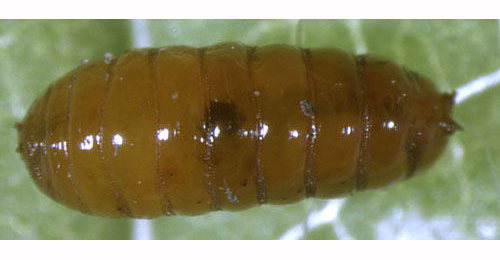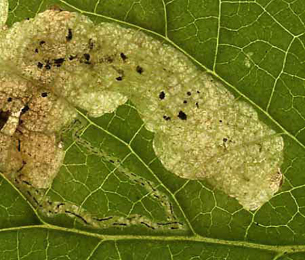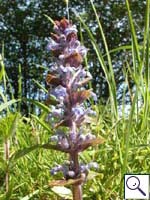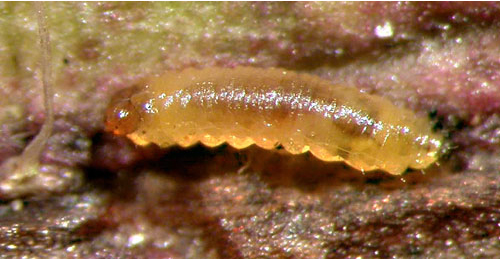|
||||||
|
AJUGA. Bugles. [Lamiaceae] |
|
|
Four species of Ajuga are recorded in Britain. These include the native Ground-pine (A. chamaepitys (L.) Schreb.), Pyramidal Bugle (A. pyramidalis L.) and Bugle (A. reptans L.). The BSBI provide a downloadable plant crib for Ajuga. Ground pine is protected under Schedule 8 of the Wildlife and Countryside Act, 1981. Pyramidal Bugle is protected in Northern Ireland under Schedule 8 of the Wildlife (Northern Ireland) Order, 1985. Ten British miners are recorded on Ajuga. A key to the European miners recorded on Ajuga is provided in Bladmineerders van Europa. |
|
Key for the identification of the known mines of British |
|||||||||||||||||||||||||||||||||
Note: Diptera larvae may live in a corridor mine, a corridor-blotch mine, or a blotch mine, but never in a case, a rolled or folded leaf, a tentiform mine or sandwiched between two more or less circular leaf sections in later instars. Pupation never in a cocoon. All mining Diptera larvae are leg-less maggots without a head capsule (see examples). They never have thoracic or abdominal legs. They do not have chewing mouthparts, although they do have a characteristic cephalo-pharyngeal skeleton (see examples), usually visible internally through the body wall. The larvae lie on their sides within the mine and use their pick-like mouthparts to feed on plant tissue. In some corridor miners frass may lie in two rows on alternate sides of the mine. In order to vacate the mine the fully grown larva cuts an exit slit, which is usually semi-circular (see Liriomyza huidobrensis video). The pupa is formed within the hardened last larval skin or puparium and as a result sheaths enclosing head appendages, wings and legs are not visible externally (see examples). See Key to non-Diptera. |
|||||||||||||||||||||||||||||||||
1a > Leaf-miner: The mine begins as a long, quite narrow corridor, usually not far from the tip of a leaf segment. Usually this corridor follows the leaf margin for some distance, but it may also run freely through the blade and may then be stongly contorted. In the end the corridor is directed towards the midrib, where an elongated blotch is formed, overlying the midrib and some of the larger lateral veins. Frass in a nearly continuous line in the initial corridor, in scattered lumps in the later part of the mine. Primary and secondary feeding lines very conspicuous when seen in transparancy. Pupation outside the mine. The mine starts as a very narrow corridor, usually close to the tip of a leaf segment and following the leaf margin. The later section of the corridor approaches the main vein, where an elongated blotch is made with long broad finger like extensions that lay over the secondary veins. In the initial corridor the frass forms an almost continuous line, in the blotch it is distributed in large scattered lumps. In fresh mines the secondary feeding lines are clearly visible. |
|||||||||||||||||||||||||||||||||
|
|||||||||||||||||||||||||||||||||
Trypeta zoe Meigen, 1826 [Diptera: Tephritidae]. |
|||||||||||||||||||||||||||||||||
1b > Leaf-miner: An initially linear mine, which at second instar develops into a large whitish blotch with conspicuous black frass. The early linear mine is frequently entirely enveloped by the blotch but is detectable by the alternate irregular strips of frass. Pupation external (Spencer, 1976: 158). The first part of the mine consists of a long, slender upper-surface corridor. After the first moult this changes into a large primary blotch without feeding lines. Frass in the corridor in short, somewhat angular thread fragments, towards the end even in grains. Frass arranged less closely along the sides than in A. lamii. Pupation outside the mine. The frass is conspicuous in the mine and the mine is initially linear, then develops into a white blotch, often enveloping this early mine. |
|||||||||||||||||||||||||||||||||
|
|||||||||||||||||||||||||||||||||
Amauromyza morionella (Zetterstedt, 1848) [Diptera: Agromyzidae]. |
|||||||||||||||||||||||||||||||||
1c > Leaf-miner: A linear-blotch mine, first instar mine is linear, later developing into a conspicuous white blotch. Frass greenish diffused (Spencer, 1972b: 46, 47 (fig. 138); Spencer, 1976: 166). The mine begins with a long, upper-surface, slender corridor. After a moult the larva changes its behaviour, and makes a large, upper-surface primary blotch without apparent feeding lines. Often the blotch overruns more or less the initial corridor. Frass in the corridor liquified to form a wide green band, with a few tiny black granules along the sides. Pupation outside the mine. A narrow gallery leading to a largish blotch on the upper surface. Frass is green and indistinct in the gallery - small grains may be seen at the gallery edge. |
|||||||||||||||||||||||||||||||||
 Amauromyza labiatarum puparium Image: © Willem Ellis (Bladmineerders van Europa) |
|||||||||||||||||||||||||||||||||
|
|||||||||||||||||||||||||||||||||
Amauromyza labiatarum (Hendel, 1920) [Diptera: Agromyzidae]. |
|||||||||||||||||||||||||||||||||
1d > Leaf-miner: Initially a long, slim corridor, the frass alternating on either the side of the corridor. After moulting, the larva broadens the mine and the frass is less regular. Pupation external. |
|||||||||||||||||||||||||||||||||
 Mine of Amauromyza lamii on Stachys sylvatica Image: © Willem Ellis (Bladmineerders van Europa) |
|||||||||||||||||||||||||||||||||
|
|||||||||||||||||||||||||||||||||
Amauromyza lamii (Kaltenbach, 1858) [Diptera: Agromyzidae]. |
|||||||||||||||||||||||||||||||||
1e > Leaf-miner: A short, irregular, linear upper surface mine on any part of the leaf. Also recorded from young pods (Bland, 1997a). Long corridor mine. As a rule the first part of the mine is lower-surface, the later part upper-surface. Often the loops are so dense that a secondary blotch is the result. Because upper- and lower-surface corridor segments often cross, the mine obtains a strange array of transparant patches. There is no association with the midrib. Frass in strings and thread fragments. Pupation outside the mine; exit slit in upper epidermis. Mine not associated with the veins or midrib of the leaf (It is this character which enables distinction from another Agromyzid pest species - Liriomyza huidobriensis). The larvae may leave one leaf (if not large enough) and enter another leaf, via the petiole). It exits the leaf to pupate through a semi-circular slit in the upper surface of the leaf. |
|||||||||||||||||||||||||||||||||
|
|||||||||||||||||||||||||||||||||
Liriomyza bryoniae (Kaltenbach, 1858) [Diptera: Agromyzidae]. |
|||||||||||||||||||||||||||||||||
1f > Leaf-miner: A distinctive mine primarily above mid-rib, with irregular short lateral offshoots into leaf blade. Pupation external (Spencer, 1972: 51 (fig. 172), 55; Spencer, 1976: 270, 271 (fig. 486)). Branched, whitish, upper-surface corridor; main axis overlying the midrib; side branches overlying the main lateral veins. (In Campanula and Phyteuma the mine is much less branched, sometimes nothing more than a corridor on top of the midrib). Frass in rather long strings. Usually the mines begins as a long and narrow, shallow, tortuous lower-surface corridor that ends upon the midrib but otherwise is not associated with the leaf venation. Often this initial corridor is filled with callus, and then even less conspicuous. Pupation outside the mine. A linear mine on the upper surface, usually following the midrib and showing side branches along the veins. The frass is in strings. |
|||||||||||||||||||||||||||||||||
|
|||||||||||||||||||||||||||||||||



